Whenever I miss seeing my Guru, Shri Gurumayi, in her physical form, I find comfort and solace from the gopis’ experience in the Raslila. The gopis were also missing and looking for their Guru, Lord Krishna, searching frantically in the forest. Their minds became illuminated with the Truth when the forest inhabitants whispered back that the Lord is in everything and everyone.
This is a great teaching for me!
Ville St. Laurent, Canada
Reading about the
Raslila brings forth the following words in my heart about my beloved Gurumayi:
I came to Gurumayi when I needed her, or she came to me; she gave shelter to my feelings, turning them into a
raslila. When I reflect, when I seek her out, when I adore her, when understanding arises in me from her teachings, when I absorb myself in the practices, my own
raslila manifests, just like that of the
gopis with Lord Krishna.
I walk inside and I find Gurumayi. I walk outside and I find Gurumayi.
May we all dance the
raslila!
Mexico City, Mexico
Chapter VI of the Raslila describes communion with nature in its infinite manifestations, and invites us to chant the name of Shri Krishna with love. This all takes me back to one of those unique moments in life.
In May 1995, I first visited Shree Muktananda Ashram on Mother’s Day weekend; everyone in the Ashram was chanting the name of Shri Krishna day and night. For me, it was an absolutely respectful experience of the darshan of the Lord and the beginning of everything, culminating in this experience that would change my life forever—as I heard about Gurumayi and the entire Siddha Yoga lineage, as I saw her photo and heard the mantras, and as I listened to the experiences of a great friend of our family, an authentic gopi who had planted in my heart and in my husband’s heart a longing for holy things.
Miguel Pereira, Brazil
I have read one chapter of the Raslila per day and remembered it in the middle of my activities. This maintained my awareness of the Lord, who is always taking care of his creatures, and looking for their happiness.
The presence of the Lord in my heart is my greatest fortune. I know that my duty is to spread my love in the world around me. I enjoy doing so and seeing the Lord waving back, reflecting my love with a big smile.
Rodez, France
I have experienced the Raslila happening within me. I become the gopis, making my way through the world, encountering delightful experiences of my Lord, which are sometimes veiled with the range of human emotions. At other times I catch glimpses of the divine nature of the One I love within me. At still other times I merge into my Lord.
Such a great play happening within me—through the grace of my Guru!
Washington, United States
After reading this beautiful rendition of the
Raslila, I recognized that I have experienced something like what the
gopis felt as they danced with Lord Krishna at the end of the story. For me, this happened when chanting and participating in a dancing
saptah with Gurumayi. I realized that the Guru’s love is always there; I just have to find her in my heart.
Colwall, United Kingdom
This is such a beautiful and enchanting story. I feel that it helps me connect to my own inner love, beauty, and tenderness. At the same time, it gives me a sense of respect for and recognition of the sacredness of nature. It shows me that nature is an expression of God’s power. Reading this story has left me with a feeling of gentle care for God’s manifestation in every form.
Rome, Italy
The beautiful story of the
Raslila touches my heart. This rendering has brought me so much deep understanding. It speaks to my longing to know God and to live with the awareness of God’s presence in the days and nights of my life. I am grateful for this longing because it is flavored with the sweetness of hope and the certainty that my Guru’s grace, along with my effort to study and practice her teachings, will bring me to my goal at the proper time.
Meanwhile, I am grateful and happy to keep learning, practicing, and discovering the joy and love that is within me.
London, United Kingdom
Delving into the story of the
Raslila softens my mind and warms my heart. How beautiful to be reminded in this way: that the feeling of love and tenderness that has bathed my being so thoroughly through this path is available to me again and again when I remember to perceive the One in nature and in all. This rendering did just that for me.
I am grateful for this path and these beautiful writings that stir an alchemy of love in my mind and heart.
New Jersey, United States
As I read the
Raslila and reflected on it, I felt as if it were an abridged version of my own
sadhana. I identified with Radha in the moment when she found Krishna within herself, and she felt free. I understood that the outer form of Krishna could disappear at any time.
I realized that from one moment to the next I can lose everything external; I feel that not even my body is mine. What I do have is my own consciousness and the love in my heart. I then asked myself why it is worth striving for the experience of oneness with God. For me, this experience means the end of suffering.
Unterlangenegg, Switzerland
I am so grateful for these beautiful stories that remind me that God is within me as well as around me in nature. I feel reconnected to God’s auspicious presence. I feel fortunate to enjoy the presence of God, the Guru, Krishna in myself and in others.
Uzes, France
After reading this story, I am filled with love and drawn into silence, where I feel content, complete, whole, fulfilled, and still. I am grateful for this sacred space and for this powerful story of Lord Krishna’s love for us. The story shows me that I need to be humble to appreciate that love, to find the Self within, and to see that love in everyone and in the world.
New Mexico, United States
A number of years ago, I was fascinated by the story of the
Raslila. I too wanted to dance with the Lord.
One night, I was awakened by the sound of a flute. Although I’d never heard a bamboo flute before, I knew that it was a bamboo flute. I felt I was being called to the dance. However, I wondered where it was taking place. Where should I go to engage in this divine play? After a while, I realized that I needn’t go anywhere. I was already participating in the
Raslila every time I offered
seva, every time I attended
satsang, every time I studied the Siddha Yoga teachings.
With the understanding that the Siddha Yoga practices are filled with the
rasa of the Lord, I turned over and fell asleep, feeling totally content.
New York, United States
The
Raslila gave me a key to enter the realm of the Self and experience divine love. I experienced an initial, conditional love melting into Consciousness and becoming pure unconditional love. While savoring this divine love in the fountain of my heart, I felt love spreading everywhere, out through all my senses.
Rodez, France
Reading this brought every word to settle in my heart with loving calm and sweetness. This grounded me and reminded me that, like the
gopis, all it takes for me to experience bliss is to let go of the ego. What a refreshing outlook to carry me through this month and beyond!
Texas, United States
Such a beautiful story. One night in
satsang we chanted
Krishna Govinda Gopala with a recording of Gurumayi and ensemble. During the
namasankirtana, I became ecstatic, and during meditation my ecstasy increased. When meditation was over, I became aware of tears of joy streaming down my face. I felt totally enraptured in a divine love that reminded me of the
Raslila. My beloved Gurumayi’s divine presence lives in me, and more and more I feel I am seeing the world through her eyes.
Florida, United States
Such an astoundingly beautiful story! I could feel each of the magical moments, the loss and the pain, and the discovery of a profound truth.
I am truly grateful for this ethereal experience.
Mumbai, India
This beautifully told “Mandala of Love” went to the heart of my experience of the
sadhana of the Guru-disciple relationship. Years ago, whenever I was in Gurumayi’s presence, I longed to be special. And even now, whenever I’m with other people, I often long to feel unique or stand out or be recognized.
Recently in a yoga class, when the teacher asked us to make an intention, I reflected on this and said in my heart, “Let everyone in this class experience the same bliss.” It was pure heaven! I felt lighter, more forgiving, and more open in such subtle ways.
One of my favorite things on this amazing path is that whenever I am so fortunate as to wake up to a true understanding, at that very moment Gurumayi is right there with me. I am deeply grateful.
St. Lazare, Canada
Such a profound teaching told so enchantingly! The story so clearly demonstrates to me that the moment we get carried away with our ego, we disconnect from our divine nature, our true Self.
I have been delighting in reading and contemplating this beautiful story of selfless love and devotion. Every day I read just one chapter, the better to savor it. And every day I am given a reminder of the profound love in my heart. Today I came to the end, but will start from the beginning again tomorrow.
Lismore, Australia
I was moved by this story. It captured the essence of what it is to walk a spiritual path of devotion, discipleship, service, and love. For me, what happened to Radha and the
gopis reflects so clearly the primary challenge that arises in the mind of one who walks the path of love. It shows the way through that challenge back into the heart, and paints an inspiring picture of the reward for making it through—the state of all-pervasive divine love filling up one’s being.
This challenge and reward have been delicately balanced all through my Siddha Yoga studentship—a balance I recognize as continually playing itself out through my own life and
sadhana. I am so grateful for this path.
Hawaii, United States
This is such a beautiful story, embodying the profound message that the love we are seeking outside us is right there within us, and that this love is the Lord. My heart is full of gratitude and bliss for this reminder of the sweet power of devotion!
Massachusetts, United States
The magic and majesty of this ancient story, so beautifully told, reminds me that its truth is available to me, and to each of us, in every moment, everywhere, and for all time. I am reminded, once again, to simply attend and yield to the inner sound of Krishna’s flute, to the pure love it conveys, and follow it home to my heart of hearts, wherein the sweet Lord dwells.
Washington, United States
I feel suspended in the beauty of the night of Lord Krishna’s revelation of his true nature to the
gopis—a truly breathtaking experience.
Massachusetts, United States
While reading this, I felt I was watching the story unfold right in front of my eyes. I could feel Krishna’s radiance, divinity, and beauty. I developed a longing to have his
darshan too, so I started listening to the
Krishna Gayatri mantra right after reading this series. And it sounded even more beautiful to me than before!
I am grateful to be reminded of God’s ever-present grace and to remember that I only need to tap into it with a pure heart, just as the
gopis did.
Mumbai, India
I love this tale—so full of longing and devotion. Reading it has pulled me into my heart and into the awareness that God exists in all things, in all people, in all of nature, in my whole world.
I feel especially heartened by the reminder that I can connect with God’s love within me by loving each person and each thing present in my life, even challenges in my work. I can practice being present to each situation I encounter, recognizing God’s presence, and giving the best of myself.
Sydney, Australia
As I read how the
gopis began to experience Krishna in the trees, the flowers, the birds, and all that surrounded them, I recalled my time at Gurudev Siddha Peeth in the
Pilgrimage to the Heart Retreat. I remembered how everything my eyes landed on, everything my heart witnessed, filled me with love and devotion for this path, for our Guru, for God within me and outside me. My heart teemed with such love that I felt it overflowed to all I encountered. The Guru’s love, the Guru’s grace, were there for me to share with others.
Missouri, United States
As I read these beautiful chapters of the
Raslila, I smiled and cried tears of recognition and empathy for the
gopis. I thought of the experiences I’ve had of elation, of profound connection with the Guru, often followed by wondering where those experiences that I’d hoped would last forever had gone. The story helped me see how my preoccupations had gotten in the way of maintaining my appreciation of those precious moments.
As I thought about this, like the
gopis, I became aware of deep longing to live in the experience of the Guru’s love. I feel more understanding and acceptance that only staying connected with my own heart can provide a truly happy ending for my own tale of longing.
Ohio, United States
What a divine gift this beautiful retelling of Krishna’s dance is. It helps me remember God’s love within, the beauty of God all around, and our natural inclination to celebrate, support, and love each other. Krishna’s kind, gentle, wise, and playful nature is such a beautiful reminder to me to be kind.
California, United States


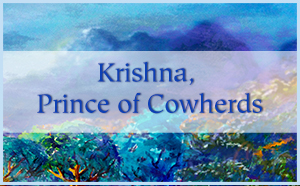

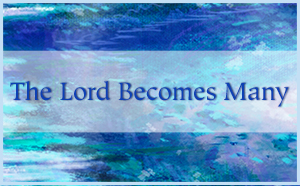
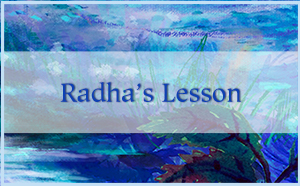
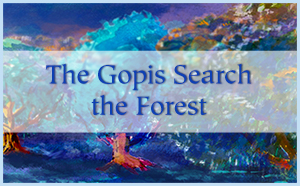
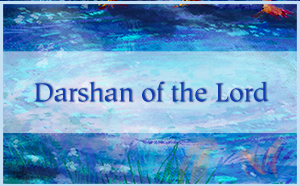
Shri Krishna was born into the royal house of the Yadav dynasty in the capital city of Mathura. At the time of his birth, his parents were prisoners of his uncle, the tyrant Kaṁsa, who had deposed the king. When Krishna was born, around midnight, the prison guards fell into a deep sleep and the doors of the prison sprang open. Krishna’s father, Vasudeva, placed the newborn baby in a basket and carried him away from the prison to keep him safe from Kaṁsa. Vasudeva crossed the raging, chest-high waters of the Yamuna River, holding the basket over his head. He took the infant to Gokul, a small village on the other side. There, in Gokul, baby Krishna was lovingly brought up by Yashoda and Nanda, a family of cowherds. Krishna grew up caring for the cattle with all the other children, bathing in the cool river, and swinging from branches in the trees.
Krishna was known as an especially delightful child, but most of the time, as he grew up among them, the people of Vrindavan were only dimly aware of his divine nature. This was because Shri Krishna was able to invoke the power of maya, or illusion, to conceal his true identity.
The Rāslīlā is a story about one of the times he revealed his divinity. “Rās” refers to the dance created by Lord Krishna when he danced with the gopis. It has been commemorated in the rās garbā, a traditional folk dance in the state of Gujarat. “Līlā” means “play” or “game.” Thus “Rāslīlā” means “the play of the dance,” and is also known as “the dance of divine love.” The story of the Rāslīlā speaks to seekers everywhere about the nature of God and the human longing for spiritual union.